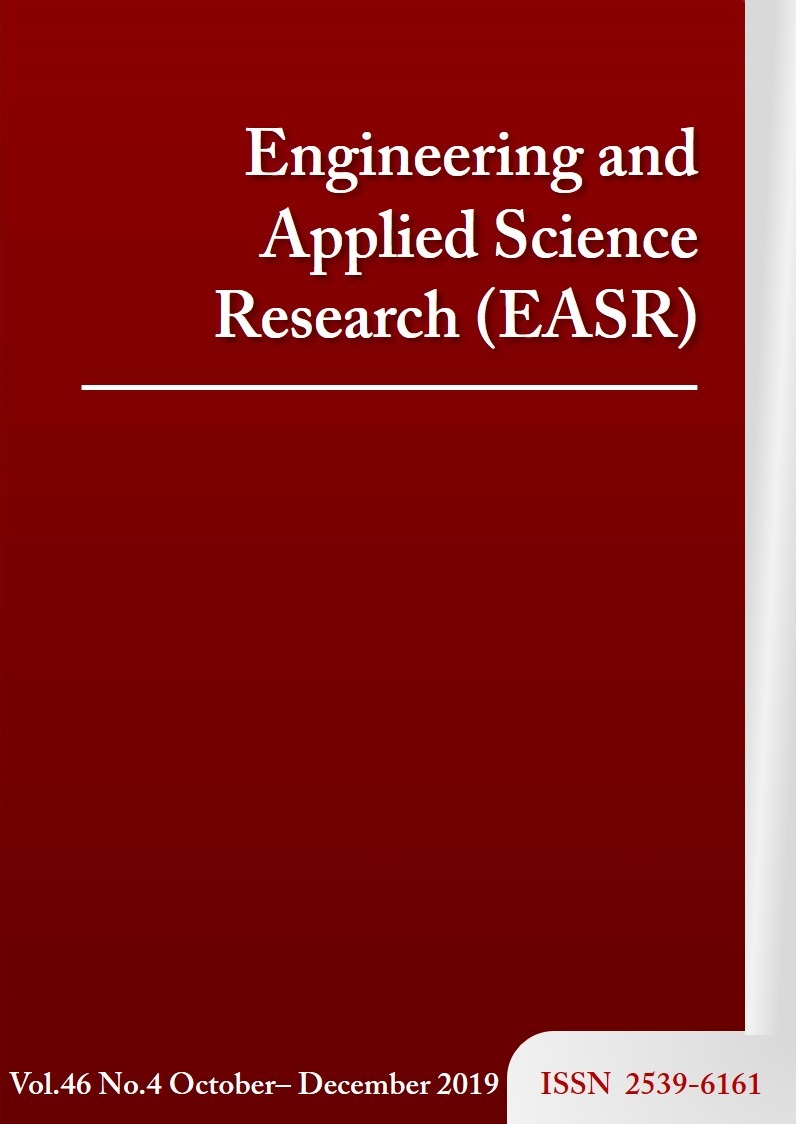Sugarcane canopy detection using high spatial resolution UAS images and digital surface model
Main Article Content
Abstract
The use of an unmanned aerial system (UAS) equipped with multispectral cameras is a potential approach to acquire canopy reflectance to make various correlations with desired crop parameters. However, the acquired reflectance data are mixed with unwanted data, such as reflectance from soil, which significantly affects some commonly used vegetation indices, such as the NDVI. This study compares the performance of three methods for detecting the canopy area of 3-month-old sugarcane crops. These methods extract the canopy areas using 5 NDVI thresholds (0.2, 0.3, 0.4, 0.5, and 0.6), a principal component analysis (PCA) threshold, and a digital surface model (DSM) threshold. The performance assessment will deliberately consider the quality percentage (QP) of each method to correctly detect the canopy area of short sugarcane crops in 10 selected images. The results show that filtration by the PCA threshold method provides the best result with a QP of 65.89-78.72%. The NDVI threshold method at levels of 0.3 and 0.4 follow with QPs of 58.42-68.81% and 40.80-70.81%, respectively, and the lowest accuracy is obtained by the DSM threshold method, which has QPs of 14.80-30.78%.
Article Details
This work is licensed under a Creative Commons Attribution-NonCommercial-NoDerivatives 4.0 International License.
References
[2] Deng L, Mao Z, Li X, Hu Z, Duan F, Yan Y. UAV-based multispectral remote sensing for precision agriculture: A comparison between different cameras. ISPRS J Photogramm Remote Sens. 2018;146:124-36.
[3] Thenkabail PS, Smith RB, De Pauw E. Hyperspectral vegetation indices and their relationships with agricultural crop characteristics. Remote Sens Environ. 2000;71(2):158-82.
[4] Huete AR. A soil-adjusted vegetation index (SAVI). Remote Sens Environ. 1988;25(3):295-309.
[5] Baret F, Guyot G, Major DJ. TSAVI: a vegetation index which minimizes soil brightness effects on LAI and APAR estimation. 12th Canadian Symposium on Remote Sensing Geoscience and Remote Sensing Symposium; 1989 Jul 10-14; Vancouver, Canada. USA: IEEE; 1989. p. 1355-8.
[6] Qi J, Chehbouni A, Huete AR, Kerr YH, Sorooshian S. A modified soil adjusted vegetation index. Remote sensing of environment. 1994;48(2):119-26.
[7] Rondeaux G, Steven M, Baret F. Optimization of soil-adjusted vegetation indices. Remote sensing of environment. 1996;55(2):95-107.
[8] Marino S, Alvino A. Hyperspectral vegetation indices for predicting onion (Allium cepa L.) yield spatial variability. Comput Electron Agric. 2015;116:109-17.
[9] Koc-San D, Selim S, Aslan N, San BT. Automatic citrus tree extraction from UAV images and digital surface models using circular Hough transform. Comput Electron Agric. 2018;150:289-301.
[10] Ke Y, Quackenbush LJ. A comparison of three methods for automatic tree crown detection and delineation from high spatial resolution imagery. Int J Rem Sens. 2011;32(13):3625-47.
[11] Santoro F, Tarantino E, Figorito B, Gualano S, D’Onghia AM. A tree counting algorithm for precision agriculture tasks. Int J Digit Earth. 2013;6(1):94-102.
[12] Recio JA, Hermosilla T, Ruiz LA, Palomar J. Automated extraction of tree and plot-based parameters in citrus orchards from aerial images. Comput Electron Agric. 2013;90:24-34.
[13] Vega FA, Ramírez FC, Saiz MP, Rosúa FO. Multi-temporal imaging using an unmanned aerial vehicle for monitoring a sunflower crop. Biosyst Eng. 2015;132:19-27.
[14] Torres-Sánchez J, López-Granados F, De Castro AI, Peña-Barragán JM. Configuration and specifications of an unmanned aerial vehicle (UAV) for early site specific weed management. PloS One. 2013;8(3):e58210.
[15] Rahman MR, Islam AH, Rahman MA. NDVI derived sugarcane area identification and crop condition assessment. Plan Plus. 2004;1(2):1-2.
[16] Ok AO, Ozdarici-Ok A. 2-D delineation of individual citrus trees from UAV-based dense photogrammetric surface models. Int J Digit Earth. 2018;11(6):583-608.
[17] Ok AO, Ozdarici-Ok A. Detection of citrus trees from UAV DSMs. ISPRS Annals of Photogrammetry, Remote Sensing and Spatial Information Sciences; 2017 Jun 6-9; Hannover, Germany. p. 27-34.
[18] Sun DW. Infrared spectroscopy for food quality analysis and control. Cambridge: Academic Press; 2009.
[19] Heege HJ. Precision in crop farming: site specific concepts and sensing methods: applications and results. Berlin: Springer; 2013.
[20] Grunow M, Günther HO, Westinner R. Supply optimization for the production of raw sugar. Int J Prod Econ. 2007;110(1-2):224-39.



